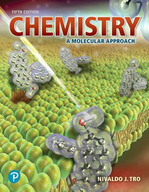Solved: ?Ethene \(\left(\mathrm{C}_{2} \mathrm{H}_{4}\right)\) can be halogenated by the
Chapter 19, Problem 87(choose chapter or problem)
Ethene \(\left(\mathrm{C}_{2} \mathrm{H}_{4}\right)\) can be halogenated by the reaction:
\(\mathrm{C}_{2} \mathrm{H}_{4}(g)+\mathrm{X}_{2}(g) \rightleftharpoons \mathrm{C}_{2} \mathrm{H}_{4} \mathrm{X}_{2}(g)\)
where \(\mathrm{X}_{2}\) can be \(\mathrm{Cl}_{2}, \mathrm{Br}_{2}\), or \(\mathrm{I}_{2}\). Use the thermodynamic data given to calculate \(\Delta H^{\circ}, \Delta S^{\circ}, \Delta G^{\circ}\), and \(K_{\mathrm{p}}\) for the halogenation reaction by each of the three halogens at \(25^{\circ} \mathrm{C}\). Which reaction is most spontaneous? Least spontaneous? What is the main factor responsible for the difference in the spontaneity of the three reactions? Does higher temperature make the reactions more spontaneous or less spontaneous?
Text Transcription:
(C2H4)
C2H4( g) + X2( g) rightleftharpoons C2H4X2( g)
X_2
Cl_2, Br_2
I_2
Delta H^circ
Delta S^circ
Delta G^circ
K_p
25^circ C
Unfortunately, we don't have that question answered yet. But you can get it answered in just 5 hours by Logging in or Becoming a subscriber.
Becoming a subscriber
Or look for another answer
